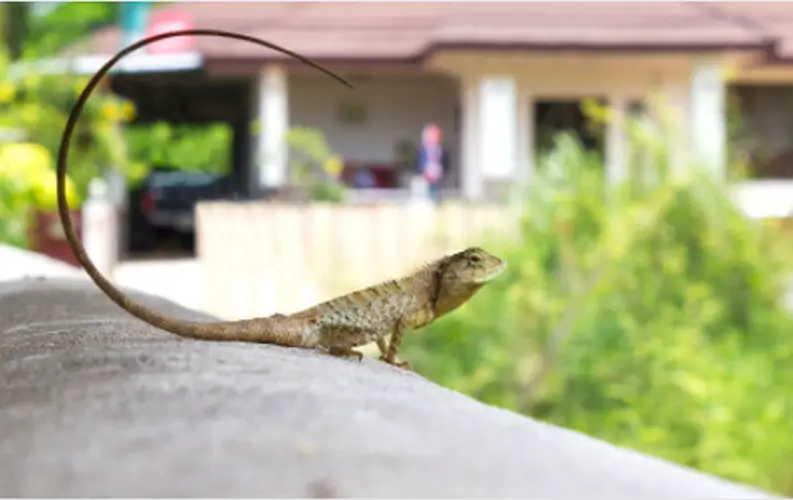Lizards belong to a group of animals known as reptiles. Currently, they are one of the largest reptiles with over 4500 species.
Lizards possess four legs, longer bodies, movable eyelids, etc., which makes them easily differentiated from snakes.
Most people might be wondering if it is a good thing to see lizards around their backyard or not.
Lizards love a hidden place that could keep them out of predators, so; whether you have an issue with seeing them in your backyard or not, you will certainly see them around.
The only problem is when they start multiplying and start looking for another food source.
Lizards can be a great pet if properly taken care of or provided with special foods. Though they might look scary or harmful but believe me, they are not.
Even if they bite you, you don’t have to worry because they don’t have any venom. They can also help to reduce pest growth in our backyard farm, which helps us prevent our plants from any damage and infections.
Types of Backyard Lizards
Knowing what species of lizard, you have near your backyard can help you determine what to do, whether to call the attention of your local pest control agency or just let them move about freely.
Squirrels and birds are not the only animals that can make their way to your backyard.
Lizards also have a way of accessing your backyard through fences. Knowing the type of lizard around your backyard will make you decide on what to do.
Although there are many species of lizard that I may not cover up in this article, below are the ones you could frequently see roaming around your backyard daily.
Southeastern five-lined skink
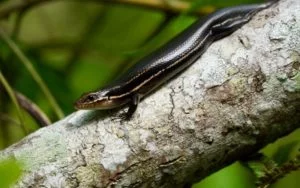
Caring for the southeastern five-lined skink requires proper housing, care, and good food. However, they make good pets. They look the same as five-lined skinks and broad-headed skinks.
Southeastern five-lined skinks are not aggressive, but they could bite when they are not properly handled, and their bite is quite painful. Their streamlined bodies make them very good at hunting insects.
They can either be brown with yellow or white strips around their bodies, gray or black with short legs.
Southeastern five-lined skinks as other skinks could live up to fifteen to twenty years; some can even live up to thirty years.
Eastern fence lizard
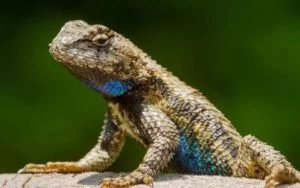
Eastern fence lizards are local to South Carolina and Georgia. These lizards are among the group of lizards with spines and rough scales.
These lizards are normally gray, but their colors may range from brown to nearly black. These lizards inhabit trees, but they can also be found on the ground. Like squirrels, when pursued, they run to the opposite side of the tree.
Eastern glass lizard
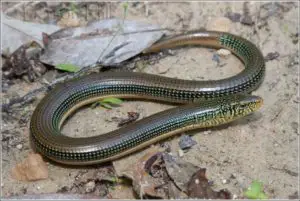
Eastern glass lizards so much look like snakes because of their long, slender, and legless nature. The only ecological difference is that snakes don’t have external ears and eyelids which they have.
Relating to other lizards, you can see the light brown, yellow, or greenish with ear-opening, inflexible jaws, and movable eyelids.
They also make good pets but should be handled with care because they are highly intelligent. They often move around in the day can take shelter at the bottom of boards or logs.
Five-lined skink
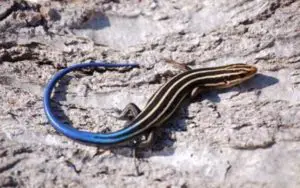
Five-lined skinks, also like Southeastern five-lined skink has the same structural component as broad-head skinks.
The difference between them is that they lose their color when they are adults and when they are younger, they possess bright blue tails.
You can see them in yellow or white stripes and at old age may develop reddish or orange colors on their head.
Ground skink
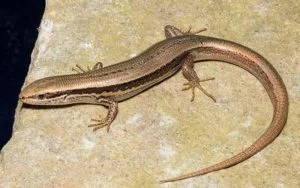
The ground skink has sturdy legs, short tails and can range from black to brown, with black to coppery brown stripes on its sides.
Unlike other reptiles, ground skinks are characterized by yellowish to white bellies. They do not climb trees, as their name implies.
It is very difficult to catch these tiny animals because their little legs run on the ground, and their bodies wriggle in loose soil, which makes them very difficult to catch.
Western fence lizard
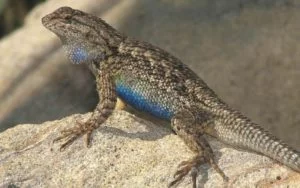
Western fence lizards are common in Northern Mexico, Utah, Idaho, Arizona, California, Nevada, Washington, Idaho, and Oregon.
According to the Academy of Science in California, Western fence lizard has been detected to have some protein that can kill Lyme, a disease-causing bacterium.
They are also part of species of lizards with rough scales. Western fence lizard eats vegetables and can survive in basically different climatic conditions.
Broad-headed skink
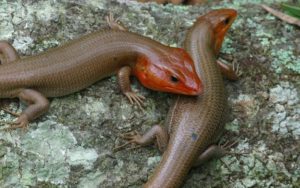
Among skinks of the Southeast region, broad-headed skinks are considered the largest. The bodies of these lizards are streamlined, while their legs are short.
A young broadhead skink has black, gray, or brown colors and five yellow or white stripes on its sides. On the bodies of adult males, the color will be uniformly brown or gray, and the color of the head will be orange.
Gecko
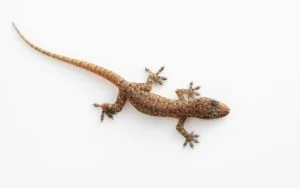
Geckos are very friendly and are also one of the lizards kept as pets. They tend to be teachable and relatively easy to be taken care of.
Due to their ability to camouflage, geckos have different colored skins. The most common geckos have a greenish, blackish, or brownish color similar to tree bark.
Green anole
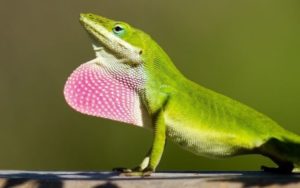
Green anole can make a good pet for children. They are easy to raise and fun to watch because of their climbing way of life.
However, depending on the nature of the environment or other atmospheric conditions, green anole lizards can either be green or brown.
In warm weather, you can find these lizards in vegetation, darting from one place to another. During cool weather, you can find green anoles under shingles, rotten logs, or tree bark.
Gila monster
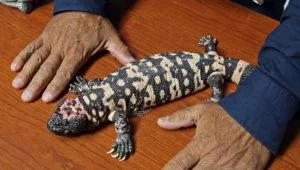
The Gila monster is a slow-moving and heavy venomous species, which is native to the Southwestern part of the United States and the northwestern Mexican state of Sonora.
They are very heavy and can reach up to 60 cm long. They always come in orange color with black stripes around their body. People have accused that since it spits venom, it could kill people its poisonous breath.
A Gila monster’s bite can only be very painful but may not cause death. They chew their food, possess scale-bodies, dry skin, have one lung, and have on the sweat gland.
What Sorts of Food do Backyard Lizard Eat?
Having learned about the different types of lizards, you could find in your backyard. It is also important to know the kind of food there eat. Some reptiles are mainly herbivorous, but most backyard lizards are carnivores.
Backyard lizards often eat small insects, ants, moths, beetles, honeybees, scorpions, slugs, grasshopper, centipedes, butterflies, maggots, flies, mites, spiders, worms, and many more.
Having a variety of foods available to them, they can maintain their nutrient levels. These insects contain essential nutrients, including protein and fat. Some of them are also known to eat small fruits and berries.
Generally, to satisfy their diet, they only need a few preys. You will often see them hunting early in the morning or late in the evening when the temperature is not too hot nor too cold.
The amount of foods that lizards eat differ with their sizes and weights, but they tend to eat almost anything they can get their hands on, or in their case, their tongues.
Do the Backyard Lizards Drink Water?
The backyard lizard needs water to survive, just like any other animal, and its water consumption depends on its size.
Additionally, some lizards can extract water from their prey before eating it. However, rather than drinking from a large body of water, they often lick the mist from plants or lick the water from small water sources.
How to Encourage Your Backyard Lizards or Ones Kept as Pet
- Provide them with a shallow bowl of water in a good and protected area. But make sure you keep the bowl clean and supply them fresh and clean water regularly.
- You can plant nectar or berry, so they can attract insects for them to eat. In this way, you have made their feeding very easy and steady.
- You can compost your plants to conserve moisture for them in the soil and help them with a hidden place to attack their prey.
- Ensure that your garden has rocks, bits of bark, and logs so lizards can sun themselves, hide, and rest. It is best to place your rocks and logs near some dense bushes to protect the lizard from predators by providing shelter.
- Don’t sweep out the tree litters in your backyard so they could encourage small insects and their eggs, which will serve as food for your lizard.
- Include a pond in your backyard as somewhere to drink from, which will also encourage insects and frogs. Use some sticks or rocks as a ramp to make it easy for any lizard that falls in to get out again.
- Consider planting groundcovers and native grasses in the area. The thick ground cover makes it easy for lizards to hide.
- If you have a cat, keep it inside as much as possible since they are natural hunters and will eat lizards and skinks if they can catch them. Create a cat run or tunnel outside so your cat can go out without harming any lizard or other pets.
- Compost your veggie scraps. It will save landfill space and promote better plant growth and attract insects and snails for lizards to eat.
- Include some vines or creepers to cover your fences or walls. This will allow lizards to move up and down quickly. Include shade and heavy vegetation and areas with lots of sunlight and sparse plantings, as lizards love the variety.
Life Span of a Backyard Lizard
Generally, backyard or garden lizards have a lifespan of 1-28 years, and most species can live up to 35 years and above.
Their lifespan can also increase if they are confined, but the average lifespan is about 15 years, and they can even pass it if they learn to adapt to the place, they found themselves.
Lizards learn to enjoy the climatic conditions wherever they found themselves. They can even live successfully in your backyard for about four years without food provided they can reach out to the water.
Lizards don’t stay in a place with eggshells, garlic, bird feather, onions, and cats if you want to get rid of them in your backyard. A coffee powder can also kill them instantly.
Do Backyard Lizards Get Infected?
Backyard lizards can develop fungal infections, mouth rot, a cold, and respiratory infection. Mites, ticks, and worm diseases are also threats. Like most pets, they can fall ill if they are not properly cared for.
Sneezing, coughing, hacking, wheezing, and nasal discharge are all common symptoms associated with these infections. Skin infections caused by fungi they can endure are those found on the surface.
If any of these infections occur, all you have to do is clean their terrarium and take them to a veterinarian as soon as possible.
It is also advisable to disinfect their terrarium at least once or twice a year.
A moist environment is always suitable for lizards because it helps them feel at ease without much stress. They could even feel dehydrated if where they stay is not damp.
I would suggest that you leave food where they are and call your local veterinarian if you see one that appears sick.
During that time, your veterinarian may advise you to spray your home and surroundings with disinfectant. The mist is specifically a natural disinfectant for garden lizards.
For those who want to keep garden lizards, I recommend adding a misting system to their aquarium. In addition to that, I would also have flowers, bushes, and trees outside of my house.
Conclusion
Backyard lizards can affect our environment positively. They help you reduce the insects in your backyard that can easily enter your house.
Taking steps to limit the number of lizards in your backyard is also essential. Having hundreds of fully grown garden lizards in your backyard is not a good idea.
These reptiles often help us keep our backyard neat since they feed on those most things that could push your mind away when you intend to have some fresh air.
CHECK OUT THIS:
- What Do Backyard Bunnies Eat?
- How Far Can Raccoons Jump
- What To Do With Backyard Dog Poop
- Do Backyard Ponds Attract Mosquitoes
- Do Backyard Chickens Attract Flies
Hope this article helped you understand What Sorts of Food Does Backyard Lizard Eat? You may also want to bookmark our essay about How High a Raccoon Jump.
We would love to hear your suggestions on Sorts of Food Does Backyard Lizard Eat. All you have to do is comment below and kindly share this information on your social media accounts like Twitter and Facebook so you can reach out to those that might require this information.
If you liked this article, then please follow us on Facebook, Instagram and Pinterest.

